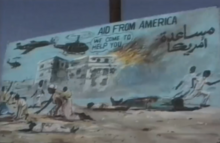| Bloody Monday raid (Operation Michigan) | |
|---|---|
| Part of UNOSOM II | |
 Sign at anti-UNOSOM protest in Mogadishu depicting 'Bloody Monday' | |
| Type | Air strike and Air assault |
| Location | |
| Commanded by | Thomas M. Montgomery |
| Objective | Kill or capture of SNA leadership |
| Date | July 12, 1993 10:18am – 10:35 (UTC+03:00) |
| Executed by | 1st Bn, 22nd Infantry and 41st Bn Engineer of 10th Mountain Division, on behalf of UNOSOM II[1] |
| Outcome |
|
| Casualties | UN forces casualties - none Somali casualties:
|
The Bloody Monday raid (Somali: Isniinta Dhiigii), also known as the Abdi House raid or Operation Michigan, was a US military operation[3] that took place in Mogadishu on 12 July 1993, during the United Nations Operation in Somalia II (UNOSOM II) phase of the UN intervention in the Somali Civil War.[4][5] Carried out by American QRF troops on behalf of UNOSOM II, the raid was the war's deadliest incident in Mogadishu to that point and a turning point in the UN operation.[6][7] It inflamed anti-UN and anti-American sentiments among Somalis, galvanizing the insurgency that the US military faced during the Battle of Mogadishu three months later.[8][9][10][7]
As part of the hunt for General Mohammed Farah Aidid after the attack on Pakistani peacekeepers on 5 June 1993, U.S. forces conducted a 17-minute raid on a villa owned by Aidid's Interior Minister, Abdi "Qeybdiid" Awale.[11][12][13] The villa was hosting a gathering attended by high-ranking elders of the Habar Gidir and other major subclans, along with prominent members of the Aidid-led Somali National Alliance (SNA).[14][15][7]
UNOSOM II claimed that the gathering was a war council composed of hardliners taking place at an SNA command center, making it a legitimate military target,[15][16] but never produced evidence to justify its claims.[17][18][19] In contrast, Somali accounts of the raid maintain that the meeting was a peace conference in which eminent elders, SNA moderates, and civilians convened to discuss a proposed diplomatic resolution to the escalating conflict between the SNA and UNOSOM II.[20][21][7][17] The 12 July operation was heavily criticized by the UNOSOM II Justice Division,[22][23] Doctors Without Borders,[21] Human Rights Watch,[18] Amnesty International,[17] and the Organization of African Unity.[24]
- ^ Cite error: The named reference
22nd infwas invoked but never defined (see the help page). - ^ UN and Somalia 1992-1996, p. 404.
- ^ Kaempf 2018, p. 116: "The raid was a unilateral US operation approved up the American chain of command to the White House. Montgomery said, 'this operation was a US operation, approved at the very highest levels in Washington before being executed'"
- ^ Cite error: The named reference
:8was invoked but never defined (see the help page). - ^ Richburg, Keith B. (6 December 1993). "In War on Aideed, U.N. Battled Itself". The Washington Post. ISSN 0190-8286. Archived from the original on 6 August 2022. Retrieved 12 March 2022.
- ^ Peterson 2000, p. 132.
- ^ a b c d Pouligny 2006, p. 179.
- ^ Peterson 2000, p. 125-126.
- ^ Hirsch, John L.; Oakley, Robert B. (1995). Somalia and Operation Restore Hope : reflections on peacemaking and peacekeeping. Washington, D.C. ISBN 1-878379-41-0. OCLC 32200261.
{{cite book}}: CS1 maint: location missing publisher (link) - ^ Murphy, Ray (2007). UN peacekeeping in Lebanon, Somalia and Kosovo : operational and legal issues in practice. Cambridge: Cambridge University Press. pp. 191–193. ISBN 978-0-511-28668-1. OCLC 644180443.
- ^ Richburg, Keith B. (5 August 1993). "U.N. Report Criticizes Military Tactics of Somalia Peace Keepers". The Washington Post. Retrieved 14 March 2022.
- ^ Bowden, Mark. "A Wrong Turn In Somalia-- An Ill-Conceived Copter Raid Turned Many Somalis Against U.S. Forces". The Seattle Times. The Philadelphia Inquirer. Archived from the original on 27 October 2021.
- ^ Wheeler, Nicholas (2000). Saving Strangers: Humanitarian Intervention in International Society. Oxford University Press. p. 197. ISBN 0-19-829621-5.
- ^ UN and Somalia 1992-1996, p. 330.
- ^ a b Kaempf 2018, p. 137.
- ^ US forces, Somalia AAR 2003, p. 132.
- ^ a b c SOMALIA: Building human rights in the disintegrated state (PDF). Amnesty International. November 1995. p. 6.
- ^ a b SOMALIA FACES THE FUTURE - HUMAN RIGHTS IN A FRAGMENTED SOCIETY (PDF). Human Rights Watch. April 1995. pp. 98–101.
- ^ Peterson 2000, p. 130.
- ^ Peterson 2000, p. 118.
- ^ a b Binet, Laurence (2013). Somalia 1991-1993: Civil War, Famine Alert and a UN "Military-Humanitarian" Intervention (PDF). Médecins Sans Frontières. pp. 191–192.
- ^ "U.N. raid on villa criticized". Las Vegas Review-Journal. Associated Press. 7 August 1993. pp. 12a.
- ^ Cite error: The named reference
daily beastwas invoked but never defined (see the help page). - ^ Cite error: The named reference
:12was invoked but never defined (see the help page).